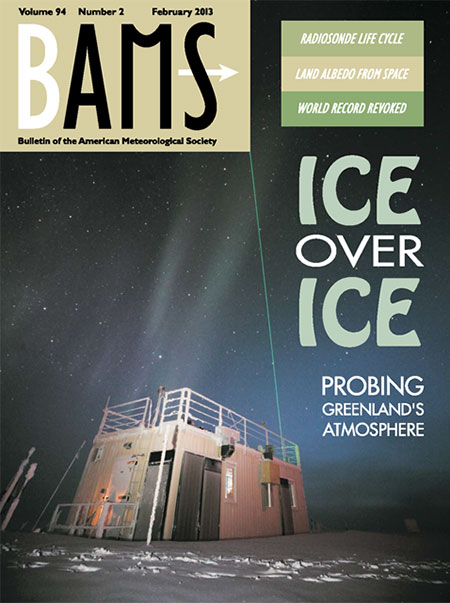March 6, 2013
High and Dry—Probing Greenland’s Atmosphere and Clouds
Scattering the skies above the Greenland Ice Sheet, seemingly innocent puffy, white clouds may be playing a key role in the region’s climate and ultimately the ice sheet’s destiny, according to a new study led by a scientist at NOAA’s Cooperative Institute for Research in Environmental Sciences (CIRES).
“Clouds are a critical element of the climate system, especially in the Arctic where surface energy budgets and precipitation can have dramatic impacts on the fate of sea ice and ice sheets,” said CIRES scientist Matthew Shupe, who works at NOAA’s Earth System Research Laboratory.
High above the Greenland Ice Sheet, the presence of clouds bodes of warmer temperatures and higher winds. Like a cushy down comforter on a bed, clouds also alter the exchange of heat, or energy, between the atmosphere and ice surface and modify the stable near-surface atmospheric conditions.
Clouds impart two competing effects on the surface energy, Shupe said. They cool the surface by reflecting sunlight, but also warm the surface by trapping thermal radiation. The balance of these depends on the detailed properties of the clouds and surrounding atmosphere, he said.
Instrument innovation: The icing on the sheet
Concerned about the impacts of these cloudy skies, in 2010, a team of scientists initiated the first detailed project looking at cloud and atmosphere properties and processes over the Greenland Ice Sheet. The initial exciting results are rolling out, many of which are highlighted in the February issue of the Bulletin of the American Meteorological Society (BAMS). The innovative project earns a coveted front cover on the journal.
The Integrated Characterization of Energy, Clouds, Atmospheric state, and Precipitation at Summit (ICECAPS) project based in Summit, Greenland, is a collaborative project among the universities of Colorado, Idaho, and Wisconsin. Perched atop the ice sheet, at 10,500 feet elevation and nearly 250 miles from the nearest town, the ICECAPS “office headquarters” is a laboratory to make any mad scientist proud.
Microwave and infrared radiometers, lidars, radars, ceilometers, sodars, and precipitation sensors squeezed into—or piled on top of—a building the size of a suburban garage provide a unique and unprecedented picture of the daily and seasonal variability of atmospheric structure, the clouds, their interactions with atmospheric radiation, and regional precipitation.  The action recorded by this plethora of instrumentation can be followed via daily imagery available at www.esrl.noaa.gov/psd/arctic/observatories/summit.
The action recorded by this plethora of instrumentation can be followed via daily imagery available at www.esrl.noaa.gov/psd/arctic/observatories/summit.
Surprisingly cloudy
The high-altitude and typically dry atmosphere at Summit wouldn’t suggest to the layperson an abundance of clouds. However, moist air masses periodically flow up over the ice sheet from warmer regions to the south. As the atmosphere cools, clouds comprised of liquid water can form, even at temperatures below the freezing point. These so-called “supercooled water” clouds are observed during all months of the year, even sometimes in the particularly cold and dry winter.
Also, when the air is extra cold, ice crystals, sometimes called “diamond dust,” form in the atmosphere, leading to outstanding optical displays.
“The optics can be phenomenal! Halos around the sun, circles overhead, sundogs, columns, rainbow arches going in many directions,” Shupe said. “I’ve never seen such complex optical displays anywhere else. And the cool thing is that these displays actually tell us something about the ice crystal shapes that are present in the atmosphere.”
The ICECAPS observations indicate that the largest atmospheric moisture amounts, cloud water contents, and snowfall occur in summer and under southwesterly flow. Surprisingly, many of the basic structural properties of clouds observed at Summit, particularly in the low-level stratiform clouds, are very similar to their counterparts in other Arctic regions in spite of the unique environment encountered on top of the ice sheet, Shupe said.

Collage of the Mobile Science Facility at Summit, Greenland including the ICECAPS instrumentation and their measured or derived products.
“The fact that Greenlandic stratiform clouds that contain supercooled liquid water are similar to their cousins observed elsewhere in the Arctic offers insight into this important cloud type,” Shupe said. “As we study these clouds in many Arctic environments, we are finding that they have self-sustaining processes, which make them resilient and persistent under many conditions.”
The ICECAPS observations and accompanying analyses will be used to improve the understanding of key cloud–atmosphere processes, Shupe said. Also, the findings will help develop and evaluate atmospheric models that have previously suffered from a dearth of data from this remote region.
Ultimately scientists rely on climate models to project the fate of the Greenland Ice Sheet and its potentially profound impacts on global sea level, Shupe said. But these models struggle to accurately represent clouds and their large contribution to the surface energy budget, he said.
“Our detailed observations and the research they support are critical for developing the understanding that is needed to properly simulate clouds and their interactions with the ice surface,” Shupe said.
Contacts:
Matthew Shupe, CIRES, Matthew.Shupe@noaa.gov, 303-497-6471
Jane Palmer, CIRES science writer, Jane.Palmer@colorado.edu, 303-492-6289

